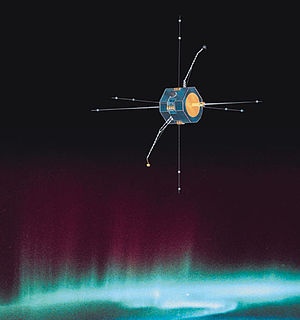
Back Fast Auroral Snapshot Explorer Czech Fast Auroral Snapshot Explorer German Fast Auroral Snapshot Explorer Greek Fast Auroral Snapshot Explorer Spanish Fast Auroral Snapshot Explorer French Fast Auroral Snapshot Explorer Galician Fast Auroral Snapshot Explorer Italian FAST (人工衛星) Japanese Fast Auroral Snapshot Explorer Portuguese Fast Auroral Snapshot Explorer Slovak
 Fast Auroral SnapshoT Explorer satellite | |
| Names | Explorer-70 FAST SMEX-2 |
|---|---|
| Mission type | Auroral plasma physics |
| Operator | NASA / Goddard Space Sciences Laboratory |
| COSPAR ID | 1996-049A |
| SATCAT no. | 24285 |
| Website | http://sprg.ssl.berkeley.edu/fast/ |
| Mission duration | 3 years (planned) 12 years, 8 months (achieved) |
| Spacecraft properties | |
| Spacecraft | Explorer LXX |
| Spacecraft type | Fast Auroral SnapshoT Explorer |
| Bus | FAST |
| Manufacturer | Goddard Space Flight Center |
| Launch mass | 187 kg (412 lb) |
| Payload mass | 65.3 kg (144 lb) |
| Dimensions | 1.02 × 0.93 m (3 ft 4 in × 3 ft 1 in) |
| Power | 60 watts |
| Start of mission | |
| Launch date | 21 August 1996, 09:47:26 UTC |
| Rocket | Pegasus XL (F13) |
| Launch site | Vandenberg Air Force Base, Stargazer |
| Contractor | Orbital Sciences Corporation |
| Entered service | 21 August 1996 |
| End of mission | |
| Deactivated | 4 May 2009 |
| Last contact | 4 May 2009 |
| Orbital parameters | |
| Reference system | Geocentric orbit |
| Regime | Low Earth orbit |
| Perigee altitude | 346.8 km (215.5 mi) |
| Apogee altitude | 3,497.8 km (2,173.4 mi) |
| Inclination | 82.97° |
| Period | 125.43 minutes |
| Instruments | |
| Electric Field and Langmuir Probe Experiment Electro-Static Analyzers (ESA) Time-of-Flight Energy Angle Mass Spectrograph (TEAMS) Tri-Axial Fluxgate and Search-coil Magnetometers | |
 Fast mission patch Explorer program | |
The Fast Auroral SnapshoT Explorer (FAST or Explorer 70) was a NASA plasma physics satellite, and was the second spacecraft in the Small Explorer program (SMEX). It was launched on 21 August 1996, from Vandenberg Air Force Base aboard a Pegasus XL launch vehicle. The spacecraft was designed and built by NASA's Goddard Space Flight Center (GSFC). Flight operations were handled by GSFC for the first three years, and thereafter were transferred to the University of California, Berkeley's Space Sciences Laboratory.